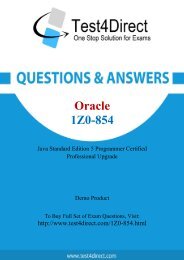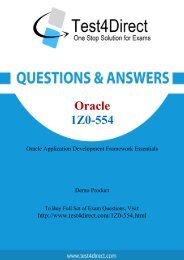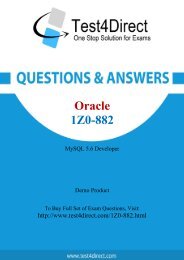Here you get free 1Z0-899 Exam BrainDumps
Test4Direct provides latest PDF questions of Oracle 1Z0-899 exam. You have an opportunity to pass the Oracle 1Z0-899 exam in one go. Test4Direct is most accurate source to prepare Oracle 1Z0-899 exam as your success will become site’s responsibility after purchasing 1Z0-899 exam product. There are also lots of discounts and promotion offers that you can avail. Let’s try a free demo http://www.test4direct.com/1Z0-899.html
Test4Direct provides latest PDF questions of Oracle 1Z0-899 exam. You have an opportunity to pass the Oracle 1Z0-899 exam in one go. Test4Direct is most accurate source to prepare Oracle 1Z0-899 exam as your success will become site’s responsibility after purchasing 1Z0-899 exam product. There are also lots of discounts and promotion offers that you can avail. Let’s try a free demo http://www.test4direct.com/1Z0-899.html
You also want an ePaper? Increase the reach of your titles
YUMPU automatically turns print PDFs into web optimized ePapers that Google loves.
Oracle<br />
<strong>1Z0</strong>-<strong>899</strong><br />
Java EE 6 Web Component Developer Certified Expert<br />
<strong>Exam</strong><br />
Demo Product<br />
To Buy Full Set of <strong>Exam</strong> Questions, Visit:<br />
http://www.test4direct.com/<strong>1Z0</strong>-<strong>899</strong>.html
Question: 1<br />
Given the element from the web application deployment descriptor:<br />
<br />
/main/page1.jsp<br />
true<br />
<br />
And given that /main/page1.jsp contains:<br />
<br />
<br />
What is the result?<br />
A. <br />
B. l2 <br />
C. The JSP fails to execute.<br />
D. <br />
< b><br />
Answer: C<br />
Question: 2<br />
A web application allows the HTML title banner to be set using a context initialization parameter<br />
called titlestr. Which two properly set the title in the scenario? (Choose two)<br />
A. $ {titlestr} <br />
B. $ {initparam.titlestr}<br />
C. $ {param [0]. titlestr} <br />
D. $ {paramValues.titleStr} <br />
E. $ {initParam [‘titleStr’] } <br />
F. $ {servletParams.titleStr} <br />
G. $ {request.<strong>get</strong> (“titleStr”) } <br />
Question: 3<br />
Answer: B, E<br />
Given:<br />
11. <br />
15. <br />
Which three EL expressions, inserted at line 15, are valid and evaluate to “3”? (Choose three)<br />
A. ${vals.2}<br />
B. ${vals [“2”] }
C. ${vals.index}<br />
D. ${vals[index] }<br />
E. ${vals} [index]<br />
F. ${vals. (vals.index) }<br />
G. ${vals [vals[index-1]] }<br />
Answer: B, D, G<br />
Question: 4<br />
Given:<br />
Which three EL expressions, inserted at line 16, are valid and evaluate to “d”? (Choose three)<br />
A. ${map.c}<br />
B. ${map.[c]}<br />
C. ${map.[“c”]}<br />
D. ${map.map.b}<br />
E. ${map.[map.b]}<br />
F. ${map. (map.b)}<br />
Question: 5<br />
Question: 6<br />
Answer: A, C, E<br />
You are building a dating service web site. Part of the form to submit a client's profile is a group of<br />
radio buttons for the person's hobbies:<br />
20. Hiking <br />
21. Sking <br />
22. SCUBA <br />
23. ><br />
After the user submits this form, a confirmation screen is displayed with these hobbies listed.<br />
Assume that an application-scoped hobbies, holds a map between the hobby enumerated type and<br />
the display name. Which EL code snippet will display Nth element of the user's selected hobbles?<br />
A. ${hobbies [hobbyEnum[N]}<br />
B. ${hobbies [paramValues.hobbyEnum[N]]}<br />
C. ${hobbies [paramValues @ ‘hobbyEnum’ @N]<br />
D. ${hobbies.<strong>get</strong>(paramValues.hobbyEnum[N]) }<br />
E. ${hobbies [paramValues.hobbyEnum.<strong>get</strong>(N)] }<br />
Answer: B
Given:<br />
1. <br />
3. ${5 + 3 It 6}<br />
4. S(requestScope['foo'][0] ne 10 div0><br />
5. ${10 div 0}<br />
What is the result?<br />
A. true true<br />
B. false true<br />
C. false true 0<br />
D. true true Infinity<br />
E. false true Infinity<br />
F. An exception is thrown<br />
G. Compilation or translation fails<br />
Answer: E<br />
Question: 7<br />
You are building a web application with a scheduling component. On the JSP, <strong>you</strong> need to show the<br />
current date, the date of the previous week, and the date of the next week. To help <strong>you</strong> present this<br />
information, <strong>you</strong> have created the following EL functions in the ‘d’ namespace:<br />
• Name : curData; signature: java.util.utilDate CurrentDate()<br />
• Name : curData; signature: java.util.utilDate addweek (java.util.Date, int)<br />
• Name: dateString; signature: java.util.String <strong>get</strong>DataString (jave.util.Data)<br />
Which EL code snippet will generate the string for the previous week?<br />
A. ${d:dateString(affWeek(curDate(), -1)) }<br />
B. ${d:dateString [addWeek[curDate[], - ]] }<br />
C. ${d:dateString [d:addWeek[d:curDate[], - 1]] }<br />
D. ${d:dateString (d:addWeek(d:curDate(), -1)) }<br />
Question: 8<br />
Answer: D<br />
Given a header in an HI IP request:<br />
X-Retries: 4<br />
A Which two retrieve the value of the header from a given HttpServletRequest request? (Choose<br />
two)<br />
A. request-<strong>get</strong>Header("X-Retries")<br />
B. request.<strong>get</strong>lntHeader("X-Retries")<br />
C. request.<strong>get</strong>RequestHeader("X-Retries")<br />
D. request.<strong>get</strong>Headers{"X-Retries").<strong>get</strong>(0)<br />
E. request.<strong>get</strong>RequestHeaders("X-Retries").<strong>get</strong>(0)<br />
Answer: A, B
Question: 9<br />
Given an HttpServletRequestrequest and HttpResponseresponse, which sets a cookie “username”<br />
with the value “joe” in a servlet?<br />
A. request.addCookie("username", "joe")<br />
B. request.setCookie("username", "joe")<br />
C. response.addCookie("username", "joe")<br />
D. request.addHeader(new Cookie("username", "joe"))<br />
E. request.addCookie(new Cookie("username", "joe"))<br />
F. response.addCookie(new Cookie("username", "joe"))<br />
G. response.addHeader(new Cookie("username", "joe"))<br />
Question: 10<br />
Answer: F<br />
Which annotation enables a servlet to efficiently process requests of typo multipart/form-data that<br />
involve large files being uploaded by the client?<br />
A. @AcceptMultipart<br />
B. @MultiPartConfig<br />
C. @MultiPartFormData<br />
D. @WebServlet (multipart = true)<br />
Answer: B<br />
Explanation:<br />
Reference:<br />
http://www.scribd.com/ilinchen2008/d/38764279-Servlet3-0-Specs (page 22, last paragraph)
THANKS FOR TRYING THE DEMO OF OUR PRODUCT<br />
Visit Our Site to Purchase the Full Set of Actual <strong>1Z0</strong>-<strong>899</strong> <strong>Exam</strong> Questions With Answers.<br />
http://www.test4direct.com/<strong>1Z0</strong>-<strong>899</strong>.html<br />
We Also Provide Practice <strong>Exam</strong> Software That Simulates Real <strong>Exam</strong> Environment And Has<br />
Many Self-Assessment Features. Download Free Product Demo From:<br />
http://www.test4direct.com/<strong>1Z0</strong>-<strong>899</strong>.html<br />
Money Back Guarantee<br />
Check Out Our Customer Testimonials


















